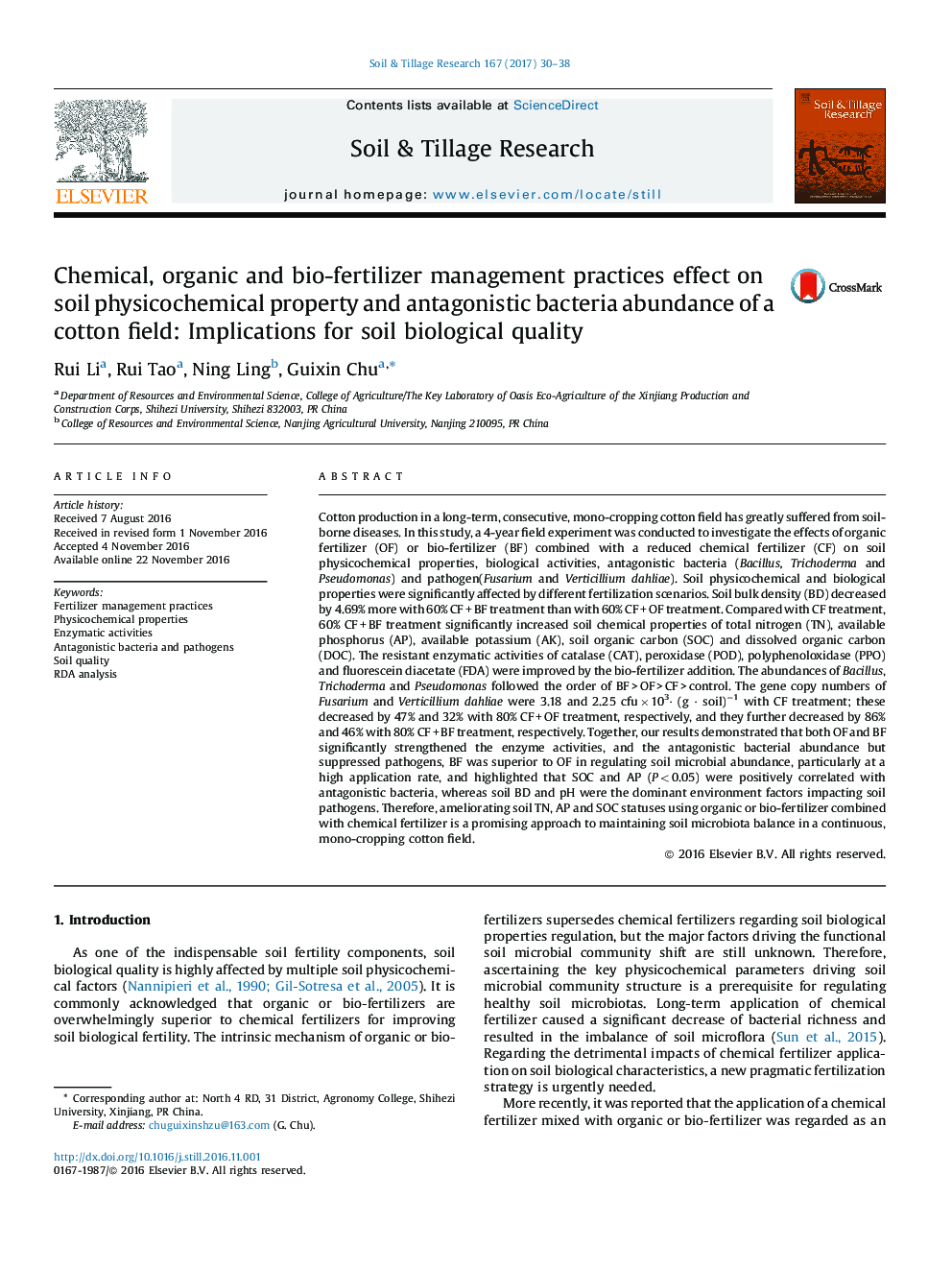| کد مقاله | کد نشریه | سال انتشار | مقاله انگلیسی | نسخه تمام متن |
|---|---|---|---|---|
| 4927591 | 1431836 | 2017 | 9 صفحه PDF | دانلود رایگان |
- Bio-fertilizer significantly decreased soil bulk density while increased soil N, P and K contents.
- Bio-fertilizer was superior to organic fertilizer in improving the enzyme activity and antagonistic bacteria abundance.
- Higher input rates of bio-fertilizer have a greater suppressive effect on Fusarium and Verticillium dahliae.
- SOC and available P were positively correlated with the Bacillus, Trichoderma and Pseudomonas.
Cotton production in a long-term, consecutive, mono-cropping cotton field has greatly suffered from soil-borne diseases. In this study, a 4-year field experiment was conducted to investigate the effects of organic fertilizer (OF) or bio-fertilizer (BF) combined with a reduced chemical fertilizer (CF) on soil physicochemical properties, biological activities, antagonistic bacteria (Bacillus, Trichoderma and Pseudomonas) and pathogen(Fusarium and Verticillium dahliae). Soil physicochemical and biological properties were significantly affected by different fertilization scenarios. Soil bulk density (BD) decreased by 4.69% more with 60% CF + BF treatment than with 60% CF + OF treatment. Compared with CF treatment, 60% CF + BF treatment significantly increased soil chemical properties of total nitrogen (TN), available phosphorus (AP), available potassium (AK), soil organic carbon (SOC) and dissolved organic carbon (DOC). The resistant enzymatic activities of catalase (CAT), peroxidase (POD), polyphenoloxidase (PPO) and fluorescein diacetate (FDA) were improved by the bio-fertilizer addition. The abundances of Bacillus, Trichoderma and Pseudomonas followed the order of BF > OF > CF > control. The gene copy numbers of Fusarium and Verticillium dahliae were 3.18 and 2.25 cfu Ã 103· (g · soil)â1 with CF treatment; these decreased by 47% and 32% with 80% CF + OF treatment, respectively, and they further decreased by 86% and 46% with 80% CF + BF treatment, respectively. Together, our results demonstrated that both OF and BF significantly strengthened the enzyme activities, and the antagonistic bacterial abundance but suppressed pathogens, BF was superior to OF in regulating soil microbial abundance, particularly at a high application rate, and highlighted that SOC and AP (P < 0.05) were positively correlated with antagonistic bacteria, whereas soil BD and pH were the dominant environment factors impacting soil pathogens. Therefore, ameliorating soil TN, AP and SOC statuses using organic or bio-fertilizer combined with chemical fertilizer is a promising approach to maintaining soil microbiota balance in a continuous, mono-cropping cotton field.
230
Journal: Soil and Tillage Research - Volume 167, April 2017, Pages 30-38
